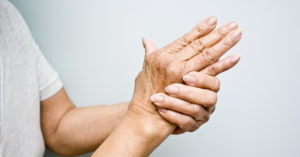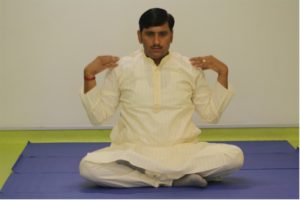By John M. de Castro, Ph.D.
“People in pain often react automatically to [what’s going on]. “You think I feel pain, and then the body tightens and you have a flurry of other thoughts like Pain is ruining my life. Mindfulness allows you to notice this distress as it happens and to intentionally step back, shifting awareness to the body and adjusting it in a way that can bring ease.” – Steven Rosenzweig
Arthritis is a chronic disease that most commonly affects the joints. Depending on the type of arthritis symptoms may include pain, stiffness, swelling, redness, and decreased range of motion. It affects an estimated 52.5 million adults in the United States. It is associated with aging as arthritis occurs in only 7% of adults ages 18–44, while 30% adults ages 45–64 are affected, and 50% of adults ages 65 or older. Due to complications associated with arthritis, the lifespan for people with RA may be shortened by 10 years.
The pain, stiffness, and lack of mobility associate with arthritis produce fatigue and markedly reduce the quality of life of the sufferers. It can have very negative psychological effects diminishing the individual’s self-image and may lead to depression, isolation, and withdrawal from friends and social activities. It even affects the individual’s physical appearance. As the quality of life deteriorates the individual can feel a loss of control and become anxious about the future. Stress can build and influence the individual’s attitude toward life and can lead to frustration, anger, and hopelessness. The physical disability produced by arthritis, reduces the individual’s ability to function at work and may require modifications of work activities. This can lead to financial difficulties. The normal chores at home may take much longer to accomplish and the individual may need the help of a relative or caregiver. Hence, it can produce stress on the entire family system.
There are no cures for arthritis. Treatments are primarily symptomatic, including weight loss, exercise, braces, pain relievers, anti-inflammatory drugs, and corticosteroids. Recently, mindfulness practices have been found to be effective in coping with the symptoms of arthritis. In today’s Research News article “Chronic pain experience on depression and physical disability: The importance of acceptance and mindfulness-based processes in a sample with rheumatoid arthritis.” See:
or below, Costa and colleagues studied the relationship between mindfulness, acceptance, disability, and depression in adult rheumatoid arthritis sufferers. They measure them for mindfulness, pain, pain acceptance, health impact of arthritis, depression, anxiety, and stress.
They found, not surprisingly, that the greater the level of pain the greater the levels of disability and depression. Higher levels of both mindfulness, especially the non-reacting facet of mindfulness, and acceptance were found to be associated with lower levels of pain, disability and depression. Performing a mediational analysis, Costa and colleagues found that the effects of pain on depression were reduced by both acceptance and non-reacting while pain’s effects on disability was reduced by only acceptance.
The results show that being non-reactinge and accepting of experience were associated with lower levels of arthritis symptoms, with acceptance associated with lower levels of both depression and physical disability and mindful non-reacting to experience associated with lower levels of depression. Depression is amplified by rumination about past pain and worry about future pain. Mindfulness focuses the individual on the present moment and thereby reduces worry and rumination. This, to some extent explains, mindfulness’ association with lower depression. Accepting the situation is also important for pain management, as fighting against pain amplifies the pain. As a result, acceptance can reduce attempts to control the pain and thereby reduce the experience of pain and the resultant symptoms of depression and physical disability.
So, improve arthritis depression, pain, and disability with mindfulness and acceptance.
“mindfulness training, which teaches people to push away troublesome thoughts, helped improve well-being in people with rheumatoid arthritis and similar diseases. Patients . . . who received the training didn’t have less pain compared to those who didn’t, but they coped better, were less tired and showed less stress. “Yes, they still have pain, but they are able to manage their pain in more constructive ways,” – Randy Dotinga
CMCS – Center for Mindfulness and Contemplative Studies
This and other Contemplative Studies posts are also available on Google+ https://plus.google.com/106784388191201299496/posts
Study Summary
Joana Costa, José Pinto-Gouveia, and João Marôco. Chronic pain experience on depression and physical disability: The importance of acceptance and mindfulness-based processes in a sample with rheumatoid arthritis. J Health Psychol, 1359105316649785, first published on June 15, 2016
Abstract
The mediating effect of acceptance and mindfulness in the relationship between pain, depression, and physical disability was examined in 55 rheumatoid arthritis patients. Results showed that the relationship between pain and depression was mediated by both nonreact and acceptance. By contrast, the relationship between pain and physical disability was mediated by acceptance but not by nonreact. This study provides evidences that the influence of these processes is different on depression and on physical disability. These findings support models that take both general measures of mindfulness and content-specific measures of acceptance into account when conceptualizing rheumatoid arthritis. Theoretical and clinical implications are discussed.









